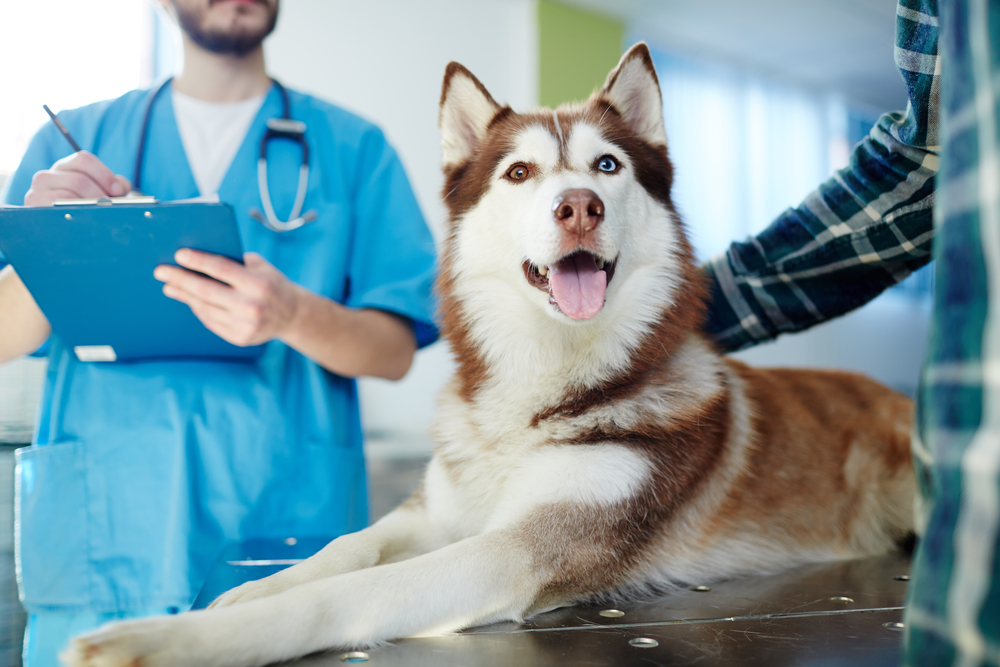Can Dogs Be Schizophrenic? Vet-Verified Mental Health Facts

Maybe your dog’s personality has suddenly done a 180. The sweet pup you cuddled with on the couch acts aggressive and perhaps growls when anyone approaches. The difference is so stark that you may wonder if your pooch is schizophrenic. Behavioral issues are problematic and the main reason behind around 10% of dogs being relinquished to shelters.1
While your pup’s behavior is odd, rest assured that your dog isn’t schizophrenic. This condition is all human and is not diagnosed in animals. Interestingly, canines share some mental health problems with people, such as obsessive-compulsive disorder (OCD) and anxiety issues. They vary depending on the genetics and physiology of the condition.


Defining Schizophrenia
Many misconceptions exist about schizophrenia. First, it’s not a split personality, as the term may suggest. A person with this brain condition may exhibit unpredictable behavior punctuated with hallucinations and delusions. They may speak incoherently or become catatonic. However, each case is unique, with its specific triggers and manifestations. It is also incurable but manageable.


Schizophrenic Signs in Dogs
Perhaps the onset of what appears to be hallucinations in a dog may lead one to think it’s schizophrenia. A dog may suddenly bark and growl at something that isn’t there. Nevertheless, remember that the canine sense of hearing is much keener than ours, with almost twice the frequency range as humans. What someone may call a figment of their imagination is something they aren’t capable of hearing.
An unfamiliar smell may also elicit a seemingly inappropriate response from a dog. Canines have the upper hand in that sense, too. You must also consider the circumstances. A pup roused from a deep sleep may be aggressive or fearful. Likewise, a pet that is in pain may act out of character. Therefore, you should take your dog to the vet if you notice an abrupt behavioral change to rule out medical causes.
Genetic Evidence
Scientists have much to learn about brain and mental health disorders across the board. Genetics can play an unforeseen role, making diagnoses and treatment more challenging. It adds to the complexity. Research has shown schizophrenia has an 81% heritability in humans.2 The disease’s presence in our genome may lie with human accelerated regions (HARs).
Research suggests a possible correlation between schizophrenia genetics and human speech.3 HARs are small DNA segments that evolved quickly in humans. The ones near genes associated with schizophrenia may have inadvertently influenced its development. The relationship between the two sets of genes may explain why this disorder is uniquely human.
Common ancestors of humans and canines diverged an estimated 80-100 million years ago. Yet, dogs have retained 84% of human DNA. The devil is in the details, as they say. The difference in the respective genomes accounts for verbal communication and perhaps the reason our canine companions aren’t schizophrenic despite their sometimes strange behavior.
At the crux of diagnosing schizophrenia in humans is the difference between signs and symptoms. The former is objective indications of disease, such as vomiting or a fever. The latter is the patient’s perception of what’s going on in their body. That involves their account of their hallucinations and delusions. Of course, we can’t get this information from a dog; we can only relate to what we observe.


Treating Behavioral Problems in Dogs
Your vet will likely begin with a physical exam of your dog to rule out other health conditions. The odd behavior may be an indirect effect of some underlying issue. That may include bloodwork and imaging with a complete medical history. One tool a vet can use is the Canine Brief Pain Inventory. It can help with a diagnosis by quantifying the intensity of your pup’s pain if that is the ultimate cause.
Rage syndrome in dogs may lead to unpredictable aggressive behavior, including staring and biting owners. It may occur in normal and non-stressful situations and in otherwise friendly dogs. Often the dogs snap out of it and return to normal behavior. Rage syndrome is idiopathic, which means the cause is unknown, but some dogs with EEG changes may respond to phenobarbital, an anticonvulsant medication. Conversely, your dog could be completely in control of their behavior which means there is an underlying reason for it such as fear, resource guarding, pain, or anxiety.
Many techniques exist to modify unwanted behavior. A common theme is positive reinforcement instead of corporal punishment. Treats and the owner’s praise are potent motivators. The treatment can be lengthy and requires compliance and consistency for long-lasting results. Your vet may even prescribe behavior-modifying drugs in some cases to support behavioral modification.
Interestingly, a study found that exposure to pet dogs and cats can reduce the incidence of schizophrenia in children. The observation was most significant if it occurred during infancy.




Frequently Asked Questions (FAQ)
How Prevalent Is Schizophrenia?
Less than 1% of Americans have schizophrenia. Many people enjoy a good quality of life despite their medical condition.
How Common Are Mental Health Disorders in Dogs?
Perhaps author Dr. Laurel Braitman describes it best in her book Animal Madness. She stated, “Every animal with a mind has the capacity to lose hold of it from time to time.” Intelligence comes with a cost. However, separation anxiety is one of the most common, and it affects about one in every four to six dogs.


Final Thoughts
Dogs sometimes act strangely for various reasons. It could be a one-time response to something happening in their environment. It can also have medical causes. While canines can develop mental disorders, schizophrenia is not one of them. This condition exists only in the human realm. Some scientists hypothesize it’s a complication of our well-developed brains and communication.
Some pets can develop mental health issues. Many have genetic causes worth investigating. We recommend discussing the problem with your vet. A physical examination and tests can determine how to deal with your pup’s odd behavior.
Featured Image Credit: Srinuan hiranwat, Shutterstock



